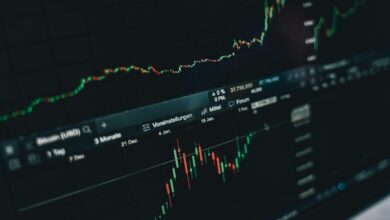Gold Investment Guide: Navigating ETFs, Physical Gold, and Mining Stocks for a Diversified Portfolio

As the global economic landscape continues to evolve, many investors are seeking safe-haven assets that can provide both stability and potential growth. Gold has long been regarded as a reliable store of value, especially during times of market volatility and inflation. However, with various avenues to invest in gold—including exchange-traded funds (ETFs), physical gold, and mining stocks—navigating the gold investment landscape can be daunting. In this article, we will break down the different options available, weighing the pros and cons of each method to help you make informed decisions. Additionally, we will explore strategic tips for effectively diversifying your portfolio with gold investments, ensuring you can harness the benefits of this timeless asset while aligning with your financial goals. Whether you’re a seasoned investor or new to the gold market, this guide will provide you with the insights needed to confidently step into the world of gold investing.
- “>2. Pros and Cons: Weighing the Benefits of Each Gold Investment Method
- understanding-your-options:-etfs,-physical-gold,-and-mining-stocks-explained“>
1. Understanding Your Options: ETFs, Physical Gold, and Mining Stocks Explained
When it comes to investing in gold, there are several avenues to consider, each with its own set of characteristics, risks, and potential rewards. Understanding these options is crucial for making informed decisions that align with your investment goals.
Gold ETFs (Exchange-Traded Funds) are a popular choice for investors seeking exposure to gold without the complexities of buying and storing physical bullion. These funds typically hold a certain amount of gold bullion, and investors buy shares that represent a fraction of that gold. The primary advantage of gold ETFs is their liquidity; they can be traded on stock exchanges just like regular stocks. Additionally, they provide a cost-effective way to gain exposure to gold prices without the need for secure storage or insurance. However, investors should be aware of management fees and the fact that they do not offer the same tangible asset ownership that physical gold provides.
Physical Gold encompasses various forms, including coins, bars, and jewelry. Investing in physical gold can be appealing for those who value direct ownership and the intrinsic worth of the metal. Physical gold is often seen as a hedge against inflation and economic instability, providing a sense of security in uncertain times. However, it comes with its own challenges, such as the need for secure storage, potential insurance costs, and the risk of market fluctuations affecting resale value. Additionally, buying and selling physical gold can involve premiums and transaction fees, which can impact overall returns.
Mining Stocks represent another way to gain exposure to the gold market. When you invest in mining companies, you are effectively investing in the business of gold production. The performance of mining stocks can be influenced by various factors, including the price of gold, operational efficiency, and mining regulations. While mining stocks can offer significant upside potential—particularly during bullish gold markets—they also carry higher risks. These stocks are subject to market volatility and company-specific risks, such as management decisions, labor disputes, and exploration challenges.
In conclusion, each investment option—ETFs, physical gold, and mining stocks—has its unique advantages and disadvantages. Investors should carefully assess their risk tolerance, investment horizon, and personal preferences when deciding how to incorporate gold into their portfolios. Understanding these options will empower you to make choices that best suit your financial strategy and goals.
3. Strategic Tips for Diversifying Your Portfolio with Gold Investments
Investing in gold can be a strategic move to diversify your portfolio, especially during times of economic uncertainty or inflation. Here are some tips to effectively incorporate gold investments into your overall strategy:
First, assess your risk tolerance and investment goals. Gold can serve as a hedge against inflation and currency fluctuations, but it can also be volatile in the short term. Determine how much of your portfolio you are comfortable allocating to gold—typically, financial advisors recommend between 5% to 10% of your total investments. This allocation should align with your long-term financial objectives and risk appetite.
Next, consider the various forms of gold investments available. Investing in gold ETFs (Exchange-Traded Funds) can provide exposure to gold prices without the need to physically store the metal. These funds are traded on stock exchanges, making them accessible and liquid. Alternatively, purchasing physical gold, such as bullion or coins, offers tangible ownership but comes with storage and insurance considerations. Mining stocks represent another approach, allowing you to invest in companies engaged in gold extraction. This method can amplify returns if gold prices rise, but it also introduces additional risks associated with operational performance and management.
Finally, keep an eye on market conditions and global economic indicators. Gold often performs well during market downturns and geopolitical tensions, so it’s important to stay informed about economic trends that may impact its price. Regularly review and rebalance your portfolio to ensure that your gold investments align with your evolving financial landscape and market conditions. By strategically integrating gold into your investment strategy, you can enhance diversification and potentially safeguard your portfolio against volatility.
In conclusion, investing in gold can be a rewarding strategy for those looking to diversify their portfolios and hedge against economic uncertainty. Whether you choose gold ETFs for their liquidity, physical gold for its tangible value, or mining stocks for their potential for growth, each option has its unique advantages and challenges. Understanding these differences is crucial in aligning your investment decisions with your financial goals and risk tolerance.
As you navigate the world of gold investments, remember to weigh the pros and cons carefully and consider integrating gold into a diversified portfolio. By employing strategic tips and remaining informed about market trends, you can make more informed decisions that enhance your investment strategy. Ultimately, gold can serve as a valuable asset in your financial arsenal, providing both security and potential for long-term appreciation.





